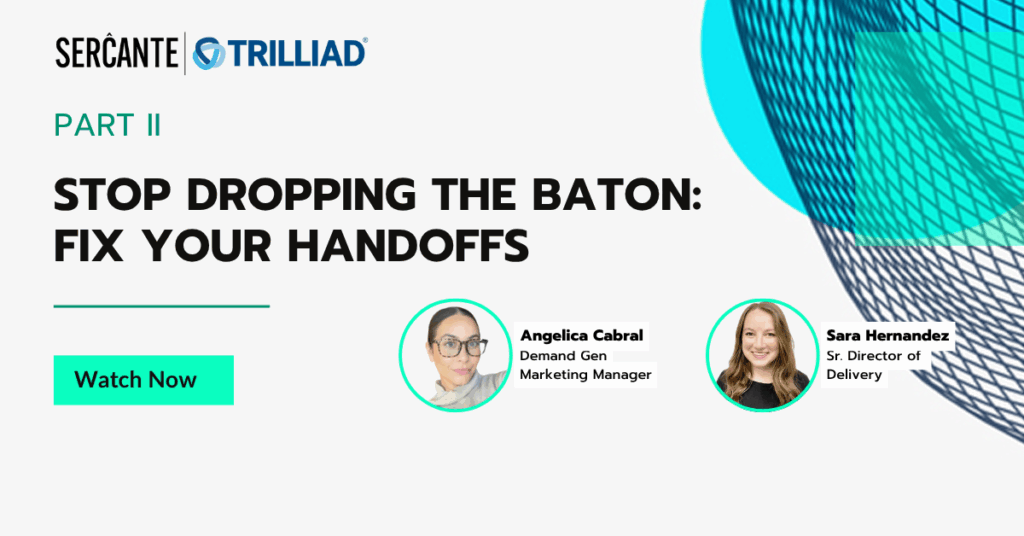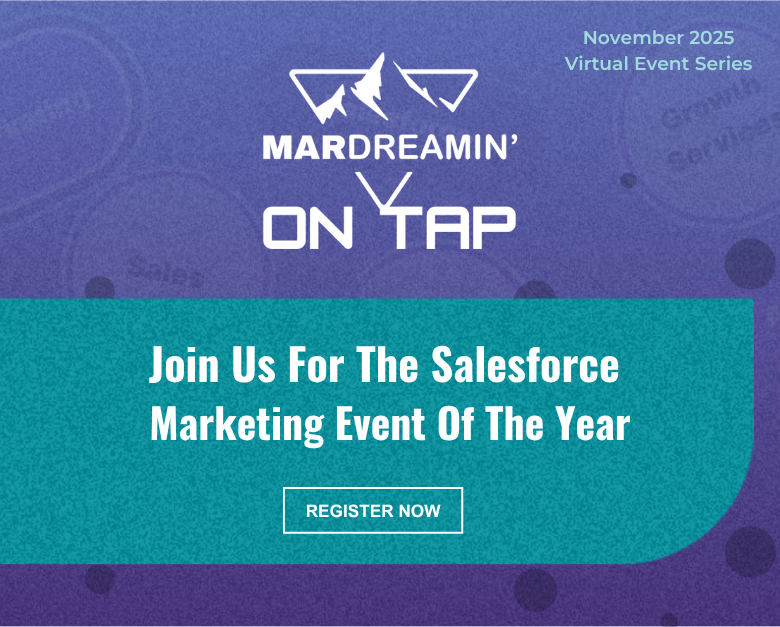Clunky handoffs between marketing, sales, and customer success are one of the most common ways teams lose momentum, drop leads, and tank trust—costing you customers. Whether it’s a hot prospect that never makes it into a rep’s queue or a new customer who has to re-explain everything they shared in discovery, these gaps compound. Which is why aligning sales, marketing, and customer success for seamless handoffs is so critical to delivering the smooth journeys today’s buyers expect.
The Sercante team shared their insights about how to approach aligning across teams for efficient transitions in Part II, Stop Dropping the Baton: Fix Your Handoffs, of our series, Built to Buy Designing the B2B Journeys Your Buyers Actually Want. The highlights from the conversation are below. Watch the full episode to get all the details.

Clunky handoffs are stunting your growth
When a buyer is easily transitioned from one department to the next, it breaks down their trust in your business. This loss of trust ultimately hurts the longevity of their potential relationship with you, impacting customer lifetime value before it has a chance to grow.
Other statistics show the impact on revenue when the teams don’t have strong cross-team collaboration for smooth handoffs.
- 10%+ of annual revenue is lost due to poor cross-team alignment (Demandbase)
- 70%+ of leads are wasted because of delayed response times (Credofy)
- It’s 5x cheaper to retain a customer than to acquire a new one (Forbes)—yet many teams fumble the transition from sales to customer success, weakening loyalty and shrinking lifetime value.
You have probably seen the above statistics before, so why does this matter now? In today’s modern era, buyer expectations are higher than ever. People don’t have the patience anymore to wait around to be followed up with, repeat themselves over and over, and if they feel like a company isn’t in sync with them, they’ll move on to the next option. 80% of buyers say that the customer experience is as important as the product itself (cropink.com, 2025), while 77% of buyers said that their last purchase was very complex or difficult (Gartner).
Therefore, creating stronger alignment and fixing your handoffs isn’t something that can be ignored.
Approaching alignment with a customer-first mindset
Approach these conversations through a customer-first lens. Think about it, if you were your buyer, what does the journey feel like today? What could be done to make it better? Answering these questions will help to focus your marketing, sales, and customer success teams around the same outcome: a seamless buying process. As you identify your areas of opportunity, write them down, and then soon you’ll be able to start digging into the customer lifecycle and the processes happening internally.
In Part I, Walk Your Funnel Like a Customer, of the series, the Sercante team shared their expertise on how to approach this exercise and then map your customer lifecycle to think about how you can define your stages, establish who owns what, improve data visibility, and create feedback loops.

Walk your funnel like a customer.
Take one of your latest customers and look at every touchpoint they had with you. How long did it take before they were followed up with? Were they waiting at all? At any point was the handoff clunky? Write it down and you’ll most likely find a few areas for improvement.
Map your stages and define ownership of each stage
Internally, what are all the stages of the customer lifecycle? Who’s responsible for what? What’s the entry and exit criteria for each stage? What happens during the transition? Make it clear.
Get the right data in front of the right people.
Visibility is everything. If customer success can’t see sales notes, or sales can’t see marketing engagement, your buyer is repeating themselves.
Build feedback loops into your process.
Alignment isn’t one and done. Create recurring meetings and shared reporting to stay in sync and fix issues before they grow.
Establishing this customer-first lens and starting to map your customer lifecycle helps to set your team up for success for the deep-dive alignment conversations throughout the different areas of the funnel.
From marketing to sales: clarify expectations with an SLA
There are several aspects that go into having strong cross-team collaboration across marketing and sales: accountability, trust, shared definitions, metrics, and reports. It can be overwhelming when looking at it as a whole. Therefore, one of the best ways to get started, as Angelica Cabral said, “Put it on paper.”
That’s where a Service Level Agreement (SLA) comes in. This doc helps teams define shared definitions, response expectations, and metrics for success. It doesn’t have to be fancy. But it does have to be clear.
Here are a few guiding questions to get started:
- How do we define a Marketing Qualified Lead (MQL)? A Sales Qualified Lead (SQL)?
- What triggers the lead handoff from marketing to sales?
- What will marketing and sales do during the handoff?
- What’s the expected response time from sales once a lead is handed off?
- How many touches should sales make?
- What metrics are both teams tracking (e.g., conversion rates, speed to lead)?
- Where will shared reports live? How often will we review them?
You can use Sercante’s SLA planner to help organize all your thoughts and use that as a base for starting to build your roadmap.

From sales to customer success: it’s a hand-hold
The customer lifespan doesn’t end at conversion. As a result, the collaboration between sales and customer success should act more “like a hand-hold” as Sara Hernandez put it, rather than a hand-off, to continue to grow the customer relationship.
To keep the experience connected, similar to the SLA exercise, the Sercante team shared the Post-Conversion Customer Alignment Guide that your teams can use to help approach the critical alignment conversations of how you’ll continue to coordinate in sync as the buyer converts.
Here are some guiding questions to get started:
- What information needs to be shared from sales to customer success and vice versa?
- What is the ideal timeframe to bring customer success into the loop?
- Where should the deal context live (and how do we keep it updated)?
- What KPIs are we tracking across sales and customer success (e.g., retention, upsell, NPS)?
- How often are we meeting to review customer progress?
Having these conversations gives your team a starting point to understand where your gaps are, where you may already be aligned, and how you can start making improvements to deliver a better buyer experience.
Don’t stop at the planning phase
A word of caution to keep in mind is: after your teams have these alignment conversations and document everything, your alignment strategy then needs to be executed. According to the 2025 Trilliad Sustainable Growth Study, where 350+ senior B2B go-to-market leaders were interviewed, 1 in 3 admit that their alignment stops at the planning phase.

Without actually executing your alignment strategy, change won’t happen, and your buyer will continue to feel clunky handoffs in the buying process.
Therefore, after you have your alignment strategy all set, take the next step and bring it into your technology, the systems that your go-to-market teams use every day, such as your CRM and marketing automation systems, to ensure that your SLA and Post-Conversion Alignment plans actually get put into practice for sustained alignment.
Seamless handoffs lead to scalable growth
At the end of the day, this isn’t just about process hygiene. It’s about the full experience your customer has with your brand and whether they choose to keep investing in that relationship.
By improving your internal handoffs, you can:
- Deliver the buyer experience, your buyers actually want
- Increase retention, loyalty, and customer lifetime value
- Reduce lead leakage and missed opportunities
- Strengthen cross-functional trust and accountability
- And make it a whole lot easier to hit those revenue targets
Because when your teams are aligned, your buyer feels it. The experience is smoother. The trust is stronger. And the results? They start compounding.
To bring in an expert resource and a strategic partner to help put your alignment goals in motion and build scalable processes that deliver seamless customer experiences, reach out to the Sercante team. We’ve helped thousands of teams succeed and bridge the gap between vision and reality for buyer experiences that build real connections and drive lasting growth.









